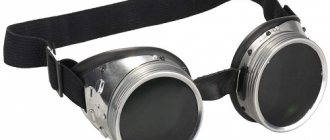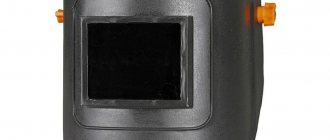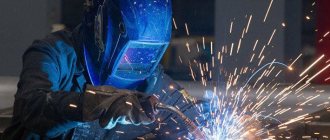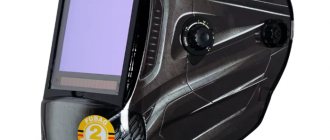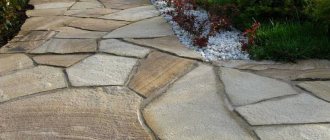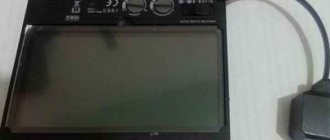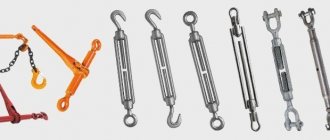Welding seams must be of high quality in order to obtain a reliable, durable connection of parts and assemblies. During their creation, safety measures must be observed and the health of the welder must be maintained. The eyes are most exposed to the harmful effects of bright radiation and high temperatures that occur during such work. Their protection is provided by a light filter for the welding helmet.
The work of a welder is dangerous and special equipment is used for protection.
Types of glass
A light filter for a welding helmet protects human eyes from thermal, infrared, ultraviolet radiation and splashes of molten metal.
When welding, cheap filters with a fixed degree of darkness (colored glass), expensive automatic filters for a welding mask (popularly called a chameleon) and polymer materials are used.
Tinted glass. To reduce light transmittance, impurities of non-ferrous metals (copper and nickel) are added to the material. Its light transmittance depends on the content of impurities in glass.
There are Russian and international markings for the degree of darkness. The domestic classification is marked from C4 to C8, which corresponds to the European 9-13 DIN. The table (below) will help you understand the correspondence of markings.
Glass Chameleon. Automatic windows use a liquid crystal screen. Liquid crystals change the construction sequence when the light voltage changes, thereby achieving different darkening. Modern filters have from 1 to 3 layers of LCD glass.
Polymer materials. They have high ductility and darkening ability.
Welding masks use combined materials, polymer film for protection against mechanical damage, and glass. Which, if necessary, are easily replaced.
Video:
Differences in glass darkness
The domestic industry supplies the market with light filters for welding marked C4-C8, corresponding to the European classification 9-13 DIN. Light-tinted glass C4 and C8 have no external differences. But C4 has less protection.
When choosing (purchasing), you can check the filter for counterfeit using a fluorescent lamp. Through glass C4 the filament of the light bulb will be clearly visible, but through glass C8 it will be difficult to see. If there are no differences, then it is better to refuse the purchase.
Pros advise having 2-3 filters with different protection for a welder’s mask. Then during welding work you can choose the best option.
The table (below) will help you select the degree of darkening of welding filters depending on the welding current and type of welding.
The table shows the recommended values. Depending on the weld, you can choose a shade that is one number less or more.
Sometimes, glass for electric welding marked E.1-E.5 comes on sale.
Chameleon light filter for welding helmet
Automatic liquid crystal filters have advantages over their fixed counterparts. Extensive settings adjust the dimming to any brightness and arc diameter.
Chameleon has several layers of crystals located in layers of polymer protection, a power supply and control unit, and arc detection sensors.
An automatic light filter is not a complicated device:
- the device is attached to the mask with two screws;
- Powered by a solar panel and replaceable batteries;
- has 3 control devices:
- Shade control 5-13 DIN and 9-13 DIN. The location is external (on the left side of the mask) or internal (on the filter itself).
- sensitivity (moment of automatic dimming) is adjusted depending on the time of day (day, night).
- dimming time adjustment (long, medium and short).
Video:
What types of filters and glasses are available for welding masks?
When welding, which is a job unsafe for human health, it is necessary to protect a person from various types of radiation: ultraviolet, infrared, thermal, as well as from iron splashes and harmful gases.
The eyesight is especially at risk of injury. Masks can neutralize the effects of hot alloy and heat. Respirator - welding gas. Light filters for welding masks allow you to protect your eyes from optical radiation.
Several types of filters are available:
- colored glass with constant tint, which belongs to a more economical price group;
- polymer products that darken due to their plasticity;
- Automatically dimming filters with LCD screens.
On extreme types of products, you should brake especially. Light filters that have automatic dimming are called “Chameleons”. They provide the highest level of eye protection.
Chameleon filters consist of:
- cells of watery crystals (their number describes the property of the glass);
- filters that do not transmit ultraviolet and infrared radiation;
- polarizing film;
- electrical unit;
- sensors for the location of the welding arc, of which there should be as many as possible;
- protective glass;
- power sources (solar batteries, lithium batteries, their compositions).
Automatic windows use a liquid crystal screen. Watery crystals change their formation sequence when the light voltage changes, thereby achieving different darkening. Modern filters have from 1 to 3 layers of LCD glass.
It is important that even in the case of disgusting operation of sensors that did not have time to darken the glass, radiation will still not be able to leak through.
Rules for choosing filters
Before purchasing masks or glasses, you should understand the optical characteristics of light filters and the specifics of using the products.
Recommendations for choosing filters for welding
- If you regularly carry out welding work, you should choose the “Chameleon” mask.
- The size of the filter determines visibility and comfort during welding activities.
- The filter response time can vary from 0.03 to 0.0001 s.
- You should choose models with continuously adjustable dimming levels, which are more comfortable than stepped ones.
- It is recommended to use universal filters that have a shade of 9-13 DIN.
- The optical class of the filter determines the clarity and visibility of the image through glass (the best option has an indicator of 1).
Additional features
Additionally, it is necessary to pay attention to: dispersion, homogeneity and angular dependence of light filters, what type of welding will be used, current indicators, the risk of mechanical effects.
When choosing protective devices, it is important to decide how the work will be carried out: indoors or outdoors.
The type of work carried out is indicated by markings: E – electric welding, G – gas welding,
B – auxiliary work, C – marking for “Chameleon” type filters.
Marking of different types of welding
To ensure uninterrupted operation of the filter, you should pay attention to:
- an adjustment unit, which can be accessed on the front side of the mask, which allows for correction without stopping work;
- on/off system that increases the longevity of the power supply and filter;
- availability of changing power sources;
- the number of sensors that determine the response time;
- possibility of adjusting parameters.
When choosing a model, it is recommended to choose filters marked 1/1/1/2, which determines the relationship to the optical class, uniformity and light dispersion.
When purchasing, it is important to study the product certificate, warranty period, and location of service centers.
Explanation of the symbols on the welding mask
Tips for use
When using masks, you must comply with certain requirements:
- Before use, check the serviceability of the welding filter using a lighter.
- If you find cracks or scratches on the filters and protective glass, you should stop using them.
- After welding operations, it is recommended to wipe the glass with a soft material (without introducing an abrasive).
- It is prohibited to allow mechanical actions on the filters (throwing masks or knocking on them).
- You need to monitor the condition of power supplies and replace them if necessary.
- The operation of filters tends to “slow down” at low temperatures, which must be taken into account when using them in winter.
If these rules are not followed, problems may arise with the operation of light filters for welding helmets.
When operating Chameleon models, you need to take into account additional aspects:
- To store masks, you must choose dry and dark places in heated rooms.
- The operating spectrum of the implementation varies from -10 to +50 degrees, otherwise there may be a decrease in the dimming properties and switching time.
- When stored in unheated rooms or in a place exposed to the sun, product failure is likely.
- Integrated batteries cannot be replaced.
- The cost of the products and their repairs are quite expensive; you need to realize that “Chameleons” can cost 10 times more than ordinary masks.
GOST regulating the characteristics of light filters
There is a special GOST 12.4.035-78 that regulates the requirements for welding helmets. Although it was developed more than 40 years ago, during this time the necessary changes were made to it, so it is still in effect today. Here we describe the basic technical requirements for welding helmets, goggles, shields, the light filters used in them and other important nuances.
There is a GOST with requirements for light filters.
List of markings
When indicating technical characteristics, the following designations are applied to the mask:
- The degree of shading is the main indicator indicating for what work the specified protective glass is suitable. In Russia, this parameter is marked with the letter C, and abroad – DIN. The higher the number, the lower the glass throughput and vice versa.
- Level of light dispersion. It characterizes the speed of the filter’s response to changes in the light flux, which increases with increasing welding current. This indicator is taken into account only for models with auto-darkening filters. There are 3 degrees, if the number 1 is indicated, then the protection works quickly, the image clarity is high.
- Uniformity of shading. In the production of colored glass, compounds of different metals are used. If the technology has been violated, they are poorly homogenized, so the material turns out to be heterogeneous, as a result, some areas of the filter will be darkened more, others less. The guarantee of high quality is 1st class.
- Optical view of glass. This indicator is influenced by the materials used for its manufacture. If the number 1 is indicated, then this filter provides darkness regardless of the angle at which the light beam hits it. The welder needs to think about the production process, and not about how to correctly turn his head in relation to the work site.
For high-quality eye protection, choose masks from reliable manufacturers with appropriate markings.
Table of correspondence between welding method and degree of darkness
According to international standards, the darkening level of filters is indicated by numbers from 9 to 13 DIN. They correspond to the Russian classification C4-C8. For example, 9 DIN = C4, and 13 DIN = C8.
Filter shades are indicated by numbers.
When choosing the degree of darkness, be sure to take into account the welding method.
To simplify this process, they act in accordance with the recommendations of international EN 379-2003, Russian GOST R 12.4.035-78.
Table: recommended shading values depending on the type of welding used
| Welding method | Current, A | |||||||
| 40 | 70 | 125 | 175 | 225 | 300 | 400 | 500 | |
| Piece electrode | 8 | 9 | 10 | 11 | 12 | 12 | 13 | 14 |
| Semi-automatic, in protective gases (carbon dioxide, nitrogen) | 8 | 9 | 10 | 11 | 12 | 12 | 13 | 13 |
| Tungsten electrode in argon environment | 9 | 10 | 10 | 11 | 12 | 12 | 14 | 14 |
| Semi-automatic, in protective gases (helium, argon) | 8 | 9 | 10 | 11 | 11 | 12 | 13 | 14 |
| MIG/with light alloys | 9 | 9 | 10 | 11 | 12 | 12 | 14 | 14 |
| Arc cutting | 10 | 10 | 10 | 11 | 12 | 13 | 14 | 15 |
| Plasma cutting | – | – | 10 | 12 | 12 | 13 | – | – |
| Microplasma cutting | 8 | 8 | 10 | 11 | 12 | 12 | – | – |
Marking of light filters, nuances of application
To measure the darkening of light filters for welding masks, special indicators are used, the markings of which have a correlation in international and domestic standards.
Darkness level of welding filters
In the international classification, the following shade values are used: 9 DIN, 10 DIN, 11 DIN, 12 DIN, 13 DIN, which correspond to domestic indicators C4, C4-C5, C5, C6-C7, C8.
Depending on the strength of the welding current, the following designations are used: E1, E2, E3, E4, E5, which determine the current strength of 30-75, 75-200, 200-400, more than 440 and more than 400 A in a shielding gas environment (respectively).
In addition to the above, manufacturers use other markings to help you choose the most suitable option:
| Designation | Application |
| U | If there is a danger of solid inclusions during welding work, the glass is protected with minerals to protect against this. |
| G1/G2/G3 | Glass is needed for gas welding of low, medium or high power |
| D1/D2/D3 | Light filters work near blast furnaces, in forges, near glass melting machines |
| P1/P2/P3 | For metallurgical work carried out at temperatures from 1200 to 1500 degrees |
| B1/B2 | During auxiliary events held in open areas |
Possible obstacles when using the light filter, tips for troubleshooting
What malfunctions of light filters may appear during welding work:
- Uneven darkening, for which you should adjust the distance between the eyes and the glasses.
- Reduced sensitivity, manifested at temperatures on the thermometer as low as -5 degrees.
- Flickering or poor darkening of the filter caused by stained glass (it is recommended to set the switch to the “Long” position).
- Dirty glass or poor lighting can cause poor visibility; in this case, the dimming level is adjusted.
Related video: “Chameleon” filter for welding helmet
Light filter for a welding helmet: what determines the choice?
During the electric welding process, the arc and melting metal emit heat and strong light. Only light filters for welding masks can protect a worker’s eyes.
They transmit a small part of the radiation, allowing you to see the weld pool, the electric arc and control the process of joining the metal. The eyes are protected from harmful radiation.
For each type of welding work, a different type of filter is selected.
Types of filters by purpose
Different types of welding differ in the type and intensity of radiation. In addition to the main worker, an assistant is often involved in the process, who is also in close proximity to the arc and burning gas. Depending on the type of work performed, glass for a welder’s mask is divided into types:
- electric welding and electric gas welding, E1 – E5;
- gas welding and gas cutting, G1 – G3;
- for auxiliary workers, B1 - B3.
For the chameleon mask, the filters are designated C3 – C8. They are used for different types of welding.
Protective glasses can be inserted with masks, goggles and face shields. Goggles can only be used when welding with gas; they do not protect the face from burns. You have to hold the shield with one hand, which limits the ability to work intensively.
Why use filters
It is enough to look at a burning incandescent light bulb for a few seconds, and its shape will be reflected on the retina. When a person looks away, he still sees this spiral everywhere for a long time.
Hot molten metal glows and emits more eye-irritating rays than an incandescent light bulb. As a result, the cornea and lens are damaged.
They suffer severe burns, which over time can lead to blindness.
Using a welding filter allows you to preserve your vision and see the most necessary elements of welding.
Types of light filters for electric welding
The first protective means for the organs of vision were dark glasses that did not transmit light. With the development of technology, convenient light filters have appeared that can change the degree of darkness depending on the radiation.
Each type has its own characteristics with positive qualities and disadvantages.
With constant
Nickel or copper is added to glass during its manufacture. They significantly reduce the amount of ultraviolet and infrared rays, reflecting them like a mirror.
You can choose the right glass based on the work to be done, markings and shading coefficient. In addition, you need to know exactly the fit size on the mask. Because glass has different sizes.
With replaceable
Polymer films can be inserted into light filters, and they change their darkening depending on the brightness of the light falling on the surface. According to this principle, glasses for everyday use, nicknamed Chameleon, are created. The disadvantage of polymer filters is their response time. When welding begins, the first rays may enter the eyes.
Such filters are additionally equipped with a polarizing protective layer that cuts off UV and IR radiation.
Polymer filters with replaceable shading are convenient for use in gas welding and cutting, where the metal gradually melts.
Diopter lenses
Diopter lenses are installed on masks, but are not independent filters. They are used as a magnifying glass when working with small parts. If a welder has poor eyesight, he should choose glass with the appropriate diopters to constantly use, since wearing ordinary glasses under a mask is problematic.
For the chameleon mask
The light filter for the chameleon mask is an electronic mechanism powered by a power supply. The main filter element is liquid crystal film. When light hits it, the crystals change their polarization and do not allow certain rays to pass through. The activity of liquid crystals depends on the strength of the current supplied to the film.
The quality of the light filter in a chameleon mask can depend on many factors. The liquid crystal base is sensitive:
- to temperature changes;
- long-term non-use;
- vibrations;
- dynamic loads;
- cleanliness of the outer glass.
The choice of mask depends on the type of work performed. Transparency adjustment is made within a certain range. The degree of protection is determined by the number of films in the filter, which can be from 1 to 3 pieces.
The filter is charged from a replaceable lithium battery or a built-in solar panel located on the front side of the mask above the glass.
The main advantage of the “chameleon” filter is that you don’t need to remove the mask to see the welding site and remove the slag. It becomes transparent in the absence of bright radiation.
How to choose
Light filters for welding masks can be selected by marking. It has 4 digits. Each of them characterizes a certain indicator.
- Optical class number. Determines the clarity of the image through the filter.
- Level of light scattering. As the value of the number increases, the image received by the eyes deteriorates, the picture becomes cloudy. Best seen with marking value 1.
- The level of darkness and the uniformity of its distribution over all glass surfaces.
- Angular dependence of darkening, its degree when rotated by 15⁰.
Welding glass markings indicate how well the arc will be visible and the degree of eye protection while welding, including turning your head slightly.
What to look for when choosing
The degree of darkness and its change
The degree of darkening of the filter is selected based on the illumination of the workplace and the strength of the welding current.
The more light and higher the current, the darker the glass should be. For masks with conventional light filters, when working outdoors or welding with a current of 300-400 A, glass number 5 is required. Indoors, it is changed to number 4. Welding at low currents of 50-120 A requires filter number 3. In chameleons, the degree of darkness is indicated in DIN. Argon, semi-automatic and manual welding with coated electrodes requires the following values:
- at currents of 40-80 A - 10-11 DIN;
- 100-150 A - 12 DIN;
- 200-300 A - 13 DIN;
- 400 A - 14 DIN;
- 500 A - 15 DIN.
Grinding mode and mask design options
If you not only need to weld, but also process metal (cutting, grinding edges, sanding the top layer of a seam, etc.), buy a mask with a grinding mode. Such PPE is equipped with a switch with “welding/grinding” positions. In the latter, the filter stops responding to sparks from the angle grinder, always remaining in a cleared state. Through it, the cutting line is clearly visible and the eyes are protected from scale. Masks with a grinding mode save time by not requiring you to regularly replace your helmet with goggles. This is very useful when working independently, when you need to weld a joint, make a cut and weld again.
Another option for grinding is masks with a convertible top, such as PREMIER Favorit SOMZ or ESAB ECO-ARC II 110*90. They have a filter with a constant degree of darkening, but it is located in a cassette that folds up. Then the welder’s eyes remain protected by ordinary glass, through which it is convenient to look while cutting or beating slag.
Number of sensors
Sensors or light sensors are responsible for detecting the electric arc flash and turning the crystals around. Budget masks usually have two sensors located under or above the viewing window. This is enough for correct operation when welding small parts in the lower or vertical positions.
If you have to weld pipes or large parts, then the sensors can be covered with the product itself, after which the crystals are rotated to make the filter clear, although the arc is still burning. Such work will lead to “catching bunnies” and retinal burns. In this case, buy a welding helmet with 4 sensors. Even if some of them are closed, the dimming will work adequately. There are even models with 5 sensors, but their price is much higher.
Connection to turbo unit
Harmful fumes and smoke when welding outdoors are blown by the wind, and indoors - due to exhaust ventilation. When you have to cook inside a large boiler, container, or other closed structure, buy a mask with a turbo unit. She has a sealed helmet, a flexible tube and a belt unit. It has a multi-stage filtration system and forced supply of purified air into the welder’s mask. This allows you to safely carry out work in specific conditions. When the battery of the ventilation unit is close to discharge, the helmet beeps, warning in time that it is time to call it a day and leave.
Choosing glass for a welding helmet
We already know that the main factor in protecting a welder’s eyes is the glass for the welding helmet.
Marking of the filter for the mask.
For targeted selection, there are special tables with various characteristics that will simplify making an informed decision:
- Functional purpose of glass.
Types of welding are listed here depending on the parameters of the welding current, power indicators, additional functions, and so on.
- The coefficient of the visual filter of the light beam.
depends on the type of welding; this is the main criterion for classifying glass.
Glass marking
There are strict standards for the classification of technical glass:
- B1, B2, B3.
These are filters for use in auxiliary work in the gas welding process.
- G1, G2, G3.
A group of filters for performing direct welding work.
- From E1 to E5.
And these filters are designed for electric welding.
- From C3 to C8.
This is the marking of all Chameleon class filters.
Classification by resistance to impacts
In addition to the type of work, welding glasses are divided according to their resistance to mechanical stress and scratches on the surface. You need to pay special attention to the tendency to scratches: their appearance on the filter can lead to a sharp deterioration in the functions of the welding helmet.
The choice also depends on the type of equipment you plan to work on. You should not buy products without labeling and at a cheap price. It's simple: good equipment cannot be cheap, especially when it comes to technical glass.
If, for example, you don’t have enough money for branded chameleons, it’s better not to buy their cheap version, but to opt for a simple filter with permanently darkening glasses.
The best way to check a cooking glass for a fake is to check it using a fluorescent lamp. If through a C4 glass filter you can clearly see the lamp filament, then through a C8 glass filter you will see almost nothing.
If there is no visual difference in the image between the filters, throw these filters and loudly say goodbye to the seller. It's better not to deal with fakes.
Table of recommendations for choosing a mask.
Professionals usually have several different mask filters to change throughout the welding process to determine the best option for a particular moment.
When choosing welding helmets with a fixed shade, in addition to the current strength, you also need to take into account the type with the electrode number.
If you weld at home and from time to time, the best option would be to choose a mask with the most universal filter. To do this, it is better to choose a darkening with parameters of at least 10 DIN - these are types from C4 and above.
If you are choosing among chameleon masks, then you should take into account the three most important factors:
- The degree of active dimming is better to choose no lower than 9.
- Glass darkening speed. The average normal speed is about 0.1 seconds.
- Filter reverse clearing speed.
Filter faults
Something is wrong with the filter:
- If the darkening is not the same on the right and left, that is, uneven, you need to adjust the distance between the eyes and the welding glass.
- The filter flickers and does not dim. Most often, the reason for this is contamination or a defect in the glass. In this case, it needs to be cleaned or replaced. If you are running low current, set the filter to "slow".
- Low sensitivity of the filter can be observed at low air temperatures, usually this level is minus 5°C.
- The reason for poor visibility is most often simple – dirty glass. Or incorrect dimming setting.
Possible malfunctions and ways to eliminate them
An automatic light filter for a welding helmet is a complex invention, and sometimes malfunctions may occur in its operation. Some can be fixed with professional repairs, while others can be fixed on your own.
| Malfunction | How to fix |
| Dimming occurs unevenly | Correct the distance between the glass and the eyes |
| Flickering, poor dimming | Clean the filter or replace it with a new one |
| Response is delayed | Move work to a room where the temperature is above -5 ° |
| Blur | Clean the filter, adjust the lighting, adjust the settings correctly |
Having knowledge about choosing a good and high-quality light filter, you can safely go to the store and buy a product that meets your needs.
What do the symbols say?
National and international estimates of the degree of obscuration differ. In Russia, indicators vary theoretically from C1 to C13. In practice, welding glasses with designations from C4 to C8 are used, the capabilities of which are quite sufficient for all types of welding.
The situation is similar in international standards. Theoretically, there are indications for welding glasses from 7 DIN to 16 DIN. In practice, glasses with values from 8 DIN to 14 DIN are used.
More information is contained in the labeling. It most often includes 4 digits.
The first digit determines the optical characteristics of the glass. They depend on the source and auxiliary materials. Belonging to class 1 means that the object through the glass is clearly visible without distortion.
The second number characterizes the ability of liquid crystals to change orientation in space in response to an increase in light flux. If 1 is indicated in the second place, a rapid darkening occurs during work, through which the work area is clearly visible without clouding.
The third number is an indicator of the uniformity of welding glass. The starting material is a mixture. With incorrect technologies, the mass may be poorly homogenized. The resulting glass will not be uniform. Roughly speaking, you can see well through it in the center, but worse on the sides or corners. 1st class – guarantee of excellent quality.
The last fourth digit is a specific glass indicator for welding helmets. If the number 1 is indicated, it means that the glass will begin to darken when a light beam hits it from any angle. This is important for stable operation. The welder should not think about what position, at what angle to the work area he should stand so that the glass darkens.
If you need high-quality eye protection, you should purchase labeled products made by well-known manufacturers. In this case, special experience is extremely important. There is no place for amateur manufacturers in the protective products market.
How to choose
Light filters for welder masks can be selected by marking . It has 4 numbers. Any of them characterizes a certain indicator.
- Optical class number. Describes the clarity of an image through a filter.
- Level of light scattering. As the value of the number increases, the image received by the eyes worsens, the picture becomes cloudy. It is most visible when the marking value is 1.
- The level of darkness and the uniformity of its distribution over all glass surfaces.
- Angular dependence of darkening, its degree when rotated by 15⁰.
The markings on the welding glass indicate how clearly the arc will be visible and the degree of eye protection when welding, including turning the head slightly.
Electric welder of the 6th category in the metal structures workshop of the LZSK plant V. P. Magriyanov: “In electric arc welding, light filters are selected according to the degree of darkening, depending on the diameter of the electrode that will be used. For example, C4 is suitable for an electrode with a diameter of 4 mm or less. The most powerful arc will blind your eyes. If, on the contrary, we take glass with a higher degree of protection, then through it it will be impossible to see the elements of the weld pool.”
The best manufacturers of welding equipment
If welding is rarely done at home, and the duration of such work is short, then you can limit yourself to buying an inexpensive Chinese light filter, but you should not count on its high quality. It is better for professionals not to save money and purchase products from popular, reliable manufacturers:
- 3M is an American company that produces not only light filters, but also shields, masks, and plates. All products are of high quality, so the manufacturer occupies a leading position in the Russian and world markets.
- Svarog is a popular Russian company that produces protective equipment and welding equipment. The advantage of their products is their affordable price and high quality.
- FUBAG is a German manufacturer that produces equipment and protective equipment for various industries and construction. Offers a large selection of replacement light filters and welding helmets.
- Quattro Elementi is an Italian manufacturer. It produces modern models with fixed filters and those that can change the level of darkness in accordance with the strength of the light flux.
- BRIMA is another German company popular in Russia, offering protective equipment used for welding by both amateurs and professionals.
The 3M company produces masks and light filters.
The best models of masks with a light filter
It is impossible to say unequivocally which model is better: when choosing a mask, they are guided by the working conditions and the preferences of the welder.
Budget variations
Amateurs who perform welding work of low complexity and infrequently should not buy a professional model. It is enough to buy an inexpensive one. Among the most popular it should be noted:
- Brima HA-1005. This is a classic inexpensive model, in which there is a fixed light filter; the glass must be raised and lowered manually. The body is made of heat-resistant plastic and weighs only 800 g.
- Quattro Elementi Lambda. The glass has a fixed degree of shading level 11 DIN. Weight – 490 g, there is a shield for protection from smoke. The forehead pad has an antibacterial coating. The mask is made of heat-resistant plastic, so it is resistant to wear and does not burn through.
- "Burevestnik NN-U1". This model is made and
